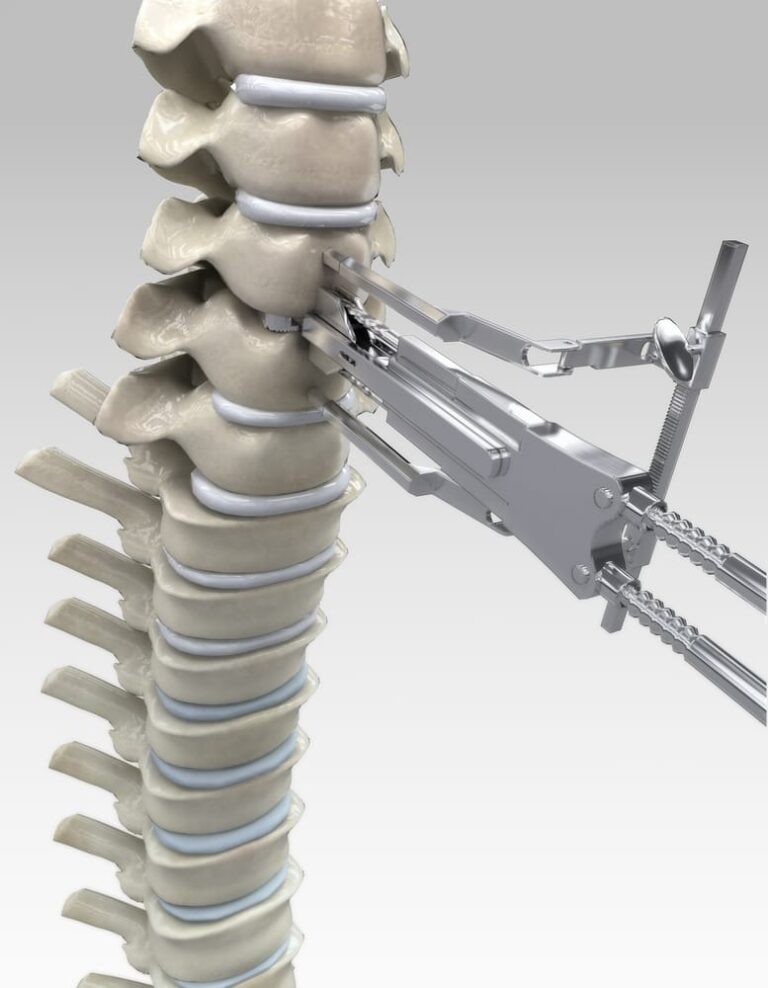
Disc Replacement Surgery, also known as artificial disc replacement or total disc arthroplasty, is a surgical procedure designed to treat chronic back pain caused by damaged or degenerated intervertebral discs. This procedure involves removing the affected disc and replacing it with an artificial one, which aims to maintain motion and flexibility in the spine, unlike traditional spinal fusion surgery that immobilizes the affected segment. Disc replacement surgery is typically recommended for patients who have not found relief from conservative treatments such as physical therapy, medications, and injections.
Disc replacement surgery, also known as artificial disc replacement or total disc arthroplasty, is a cutting-edge procedure designed to alleviate chronic back pain caused by damaged or degenerated intervertebral discs. This advanced surgical technique involves the removal of the problematic disc and its replacement with an artificial one, aiming to preserve motion and flexibility within the spine. Unlike traditional spinal fusion surgery, which immobilizes the affected segment, disc replacement surgery maintains the natural movement between vertebrae, offering a more dynamic solution to back pain.
The procedure is particularly beneficial for patients suffering from conditions such as degenerative disc disease, herniated discs, and chronic discogenic pain who have not found relief through conservative treatments like physical therapy, medications, or injections. The surgery begins with the patient under general anesthesia, followed by a small incision made either in the front of the neck for cervical discs or the abdomen for lumbar discs. The surgeon carefully removes the damaged disc material while ensuring the preservation of surrounding structures. An artificial disc, designed to mimic the natural biomechanics of a healthy disc, is then inserted into the disc space and secured in place. The goal is to restore the normal height and motion of the spine, thereby reducing pain and improving function. Recovery from disc replacement surgery generally involves a period of rest and gradual rehabilitation, with physical therapy playing a crucial role in regaining strength and mobility.
Patients often experience a quicker return to normal activities compared to those who undergo spinal fusion, and the preservation of spinal mobility reduces the risk of adjacent segment degeneration, which is a common complication in fusion procedures. Despite its many benefits, disc replacement surgery does carry risks, such as infection, implant complications, and nerve damage, making it essential for patients to thoroughly discuss their suitability for the procedure with a spine specialist. For those who are good candidates, disc replacement surgery offers a promising option for significant pain relief and improved quality of life, making it a valuable advancement in the field of spinal health.

Disc Replacement Surgery, also known as artificial disc replacement or total disc arthroplasty, is a surgical procedure designed to treat chronic back pain caused by damaged or degenerated intervertebral discs. The intervertebral discs are cushioning structures located between the vertebrae in the spine that act as shock absorbers and facilitate smooth spinal movement. When these discs become damaged due to conditions such as degenerative disc disease, herniation, or injury, they can cause significant pain and reduced mobility.
Procedure:
The disc replacement procedure involves removing the affected, damaged disc and replacing it with an artificial disc made of biocompatible materials. This artificial disc is designed to mimic the natural function and movement of a healthy disc, allowing for the preservation of spinal flexibility. The surgery is typically performed through a small incision either in the front of the neck (for cervical discs) or the abdomen (for lumbar discs), depending on the location of the damaged disc. During the operation, the surgeon carefully removes the deteriorated disc material and implants the artificial disc into the disc space.
Benefits:
The primary advantage of disc replacement over traditional spinal fusion surgery is its ability to maintain spinal motion. While spinal fusion involves fusing adjacent vertebrae together, which can limit movement and increase stress on surrounding discs, disc replacement preserves the natural range of motion and reduces the risk of adjacent segment degeneration. Additionally, patients often experience a faster recovery and return to normal activities compared to fusion surgery.
Recovery:
Post-surgery, patients typically undergo a period of rehabilitation that includes physical therapy to help regain strength and mobility. The recovery process is generally quicker than that for spinal fusion, with many patients resuming their daily activities within a few weeks to months. Physical therapy plays a crucial role in restoring function and ensuring the long-term success of the surgery.
Risks:
As with any surgical procedure, disc replacement carries potential risks such as infection, implant complications, and nerve injury. Some patients may also experience residual pain or require additional treatments. It is essential for patients to have a thorough discussion with their spine specialist to understand the potential benefits and risks before undergoing disc replacement surgery.
Disc replacement surgery, also known as artificial disc replacement, can be tailored to different parts of the spine based on the location and nature of the disc problem. The types of disc replacement surgery are primarily categorized by the region of the spine being treated:
1. Cervical Disc Replacement:
2. Lumbar Disc Replacement:
3. Hybrid Disc Replacement:
4. Total Disc Replacement:
5. Anterior vs. Posterior Approach:
Disc Replacement Surgery, like any major surgical procedure, can lead to a range of symptoms and side effects, both during the recovery period and potentially in the long term. Here’s a detailed overview of what patients might experience:
1. Postoperative Pain:
Incision Site Pain: Pain or discomfort at the site of the incision is common, whether it’s in the neck for cervical disc replacement or the lower back/abdomen for lumbar disc replacement.
Surgical Site Pain: Some pain may be felt in the area of the surgery as the body heals. This can include localized pain around the area where the artificial disc was implanted.
2. Swelling and Bruising:
Swelling: Swelling around the incision site or in the surrounding tissues is a normal part of the healing process. This can sometimes be accompanied by bruising.
Managing Swelling: Elevating the affected area and applying ice can help reduce swelling.
3. Numbness or Tingling:
Temporary Sensation Changes: Some patients may experience numbness, tingling, or altered sensations in the arms, legs, or back immediately after surgery. This is often temporary and may improve as the body heals.
Long-Term Numbness: Persistent numbness or tingling can occur if nerves were affected during the surgery or if there is an issue with the placement of the artificial disc.
4. Muscle Weakness:
Weakness in Extremities: Weakness in the arms, legs, or other areas may occur, especially if nerve roots were irritated or compressed during the surgery.
Physical Therapy: Engaging in physical therapy can help regain strength and improve muscle function over time.
5. Stiffness and Limited Mobility:
Initial Stiffness: Patients may experience stiffness and reduced range of motion in the spine following surgery. This is a common occurrence as muscles and tissues heal.
Improvement Over Time: Mobility generally improves with time and physical therapy, as long as there are no complications.
6. Swallowing or Breathing Difficulties:
Cervical Disc Replacement: For cervical disc replacements, patients may experience temporary difficulties with swallowing or breathing due to the proximity of the surgery to the throat and windpipe.
Resolution: These symptoms typically improve as the surgical area heals and swelling decreases.
7. Infection Signs:
Symptoms: Redness, increased pain, swelling, or discharge from the incision site, along with fever, can indicate an infection.
Action: If these symptoms occur, it is crucial to contact a healthcare provider immediately for evaluation and treatment.
8. Implant-Related Issues:
Complications: There may be issues related to the artificial disc, such as loosening, displacement, or wear over time. These can lead to pain or functional problems.
Monitoring: Regular follow-ups and imaging studies can help monitor the condition of the implant and address any potential issues.
9. Adjacent Segment Pain:
Potential Pain: Although disc replacement aims to maintain spinal motion, some patients may experience pain in the adjacent segments of the spine, particularly if there is increased stress on these areas.
Management: This can be managed through physical therapy, lifestyle modifications, or, in some cases, additional interventions.
10. Psychological Impact:
Emotional Response: The recovery process can be emotionally challenging, leading to feelings of frustration or anxiety. Support from healthcare providers, family, and friends is crucial for coping during recovery.
Disc replacement surgery is a significant advancement in spinal care, offering an effective solution for those suffering from chronic back pain due to damaged intervertebral discs. While the procedure generally leads to improved mobility and pain relief, patients may experience a range of symptoms and side effects during the recovery period, including postoperative pain, numbness, muscle weakness, and temporary difficulties with swallowing or breathing. Most symptoms improve over time with proper care, physical therapy, and monitoring.
For individuals considering disc replacement surgery, consulting with a skilled neurosurgeon in Indore or a neurologist in Indore is crucial. These specialists have the expertise to evaluate the condition, recommend the most appropriate treatment options, and manage any potential complications that may arise. Early consultation and expert care can enhance the effectiveness of the surgery and contribute to a smoother recovery process. If you’re experiencing symptoms that may indicate a spinal issue, seeking advice from a qualified neurosurgeon or neurologist in Indore can help ensure that you receive the best possible care and achieve optimal outcomes.